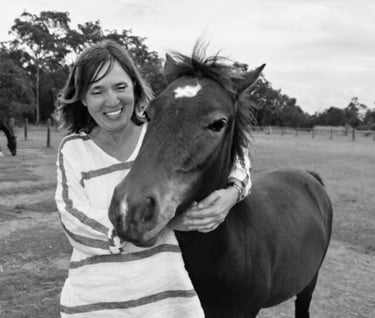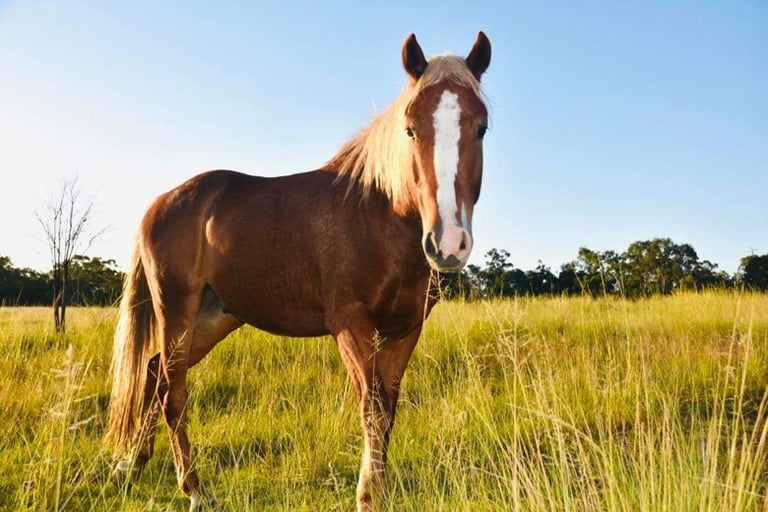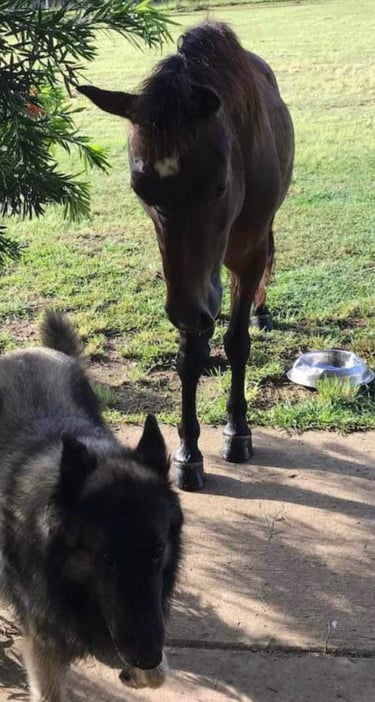“Brumbies can alleviate trauma symptoms for children and adolescents who’ve been sexually abused”
This counsellor explains why Brumbies make such valuable therapy horses
Helena Dušková-Botros
6/1/20234 min read


Helena Dušková-Botros is an experienced counsellor who uses her mob of horses – including two rescue Brumbies - to help adults and children who’ve experienced unimaginable trauma.
It’s called Equine Assisted Therapy (EAT) and Helena says Brumbies are particularly suited to it.
Helena adopted her two brumbies, called True Brumby and Little Brother, from Wollemi Brumby Haven, NSW, in 2017.
In this Blog, Helena tells us all about EAT and how her Brumbies have helped her clients.
Why are horses used in therapy?
“Clients may regress into survival mode if stressed or triggered. For example, they may feel trapped in a room with a counsellor they may not be able to relate to.
“Then they are unable to process verbally provided information.
“However with horses, they feel safer.”
What happens in EAT?
“All activities are ground-based and incorporate learning basic horsemanship skills, such as backing up a horse, asking a horse to circle around a person and jumping over obstacles.
“Other activities are designed to create a metaphor between what occurs in the arena and the participant’s every-day life.
“What emerges during these activities are patterns of thinking, reactions to different situations and outcomes, and reactions to dynamics within the family group or within the group of participants.
“Each exercise is designed to address issues such as: trust, communication, boundaries, observation, body language, attitude and self-perception.”
What makes Brumbies so good for this kind of therapy?
“Brumbies are a next-level horse.
“They are extremely intelligent, responsive and very attuned to their environment.
“They seem to sense how to respond to each individual in a way that evokes emotions, trauma, dysfunctional thinking and boundary issues that need to be recognised and addressed.
“They do so non-verbally, quite gently and they provide a non-judgemental environment where humans can process their issues and triggers.”
Tell us about your Brumbies
“True Brumby was a severely traumatised young gelding.
“He was trapped in Kosciuszko National Park along with other young Brumbies and allegedly forgotten for two weeks.
“Some of the horses died, others were in appalling condition. One lost an eye.
“They were surviving off snow as a source of hydration and whatever remnants of grass they found underneath the snow.
“True Brumby was understandably affected. His survival instinct, namely the flight response, was the first he would resort to at any given time.
“True Brumby bonded with Little Brother at the rescue haven. “
Introducing Little Brother
“Little Brother had been trapped in the Victorian High Country.
“He quickly became the darling of young children who attended therapy.
“His curiosity, trust and playfulness created wonderful metaphors about resilience for children with grief and loss issues; some due to being placed into foster care, others grieving the loss of a family member or a friend.
“After hearing Little Brother's story about the loss of his family and watching him playing with a giant ball in the pasture or challenging the other, much larger horses in a rearing contest, the children would comment on his courage and ability to have fun.
“One child said: ‘When I am sad and miss my home, I think of Little Brother and he makes me smile again.’
“The little horse also helped introverted children in groups to come out of their shells.
“First, they would talk to him, then they would start communicating with the other children.
“Many times, after therapy groups ended, the children would leave with improved communication skills - verbal and non-verbal.
“They would form friendships, and learn to respect boundaries just as they saw Little Brother respecting boundaries with the older horses.”
True Brumby was a very different can of fish.
“Suffering all that trauma, he was extremely perceptive to the slightest incongruence and would hightail across the pasture.
“He only allows one of my male clients in his vicinity.
“This male client was experiencing great sadness but could not pinpoint where all this was coming from.
“After some initial talk, I introduced him to the herd and my client's eyes gravitated to True Brumby.
“‘What's this horse's story,’ he asked. ‘I feel drawn to him.’
“I told my client Brumby's story from the beginning. My client stood very still, tears welling up in his eyes.
“‘This is my story,’ he said. ‘This is the story of my people; captured, taken away from our land, our mother and stuffed into missions. And now, living this semi-free life, our past is lost, our future is uncertain. This is over two centuries of collective pain.’
“I offered to bring True Brumby to my client, but he politely refused: ‘I know he wants to keep his distance.’
"I explained True Brumby roams free on 86 acres of land. He comes and goes as he pleases.
“Neither he nor any herd member has had a saddle on their back or a bit in their mouth since they came here.
“They are an ageing herd and have helped a lot of people. The herd is not Brumby's family, but they are his kind. It’s the best I can offer them.
“True Brumby lifted his head and walked over to us.
“Hesitantly at first, the man stretched out his hand. True Brumby sniffed the man's palm and I could see a slow smile appearing on my client's face.
“Then Brumby stretched his neck. Now they were face to face and Brumby breathed out. They exchanged breaths. Then Brumby allowed the man to stroke his neck.
“He was the first man True Brumby had allowed to touch him.
‘I think I know now,’ said the man.
‘You can't heal from centuries of collective trauma. But you can recognise it, look it in the face and then live with it. Despite it all, you can still make the best of your life in given circumstances.’
Does EAT really work?
According to the two research papers Helena has published, the answer is a resounding YES.
“The clinical outcomes are very well depicted in both research papers; significantly reduced depression, anxiety and stress symptoms.
“We used mindful breathing and brushing, which is long brush strokes, accompanied by deep breaths in and out.
“We measured clients' pulse and blood pressure pre, during, and post-interaction with horses.
“Results showed that de-escalation worked well.
“Some clients managed to synchronise their heartbeat with that of the horse.”.




Acknowledgement of Country
In the spirit of reconciliation, Saving Race acknowledges the Traditional Custodians of country throughout Australia and their connections to land, sea and community. We pay our respect to their Elders past and present and extend that respect to all Aboriginal and Torres Strait Islander peoples today.
Saving Race
Hi, I'm Keeley. I created this blog to spread awareness of how our iconic wild Brumbies have touched the lives of the humans who've saved them.
